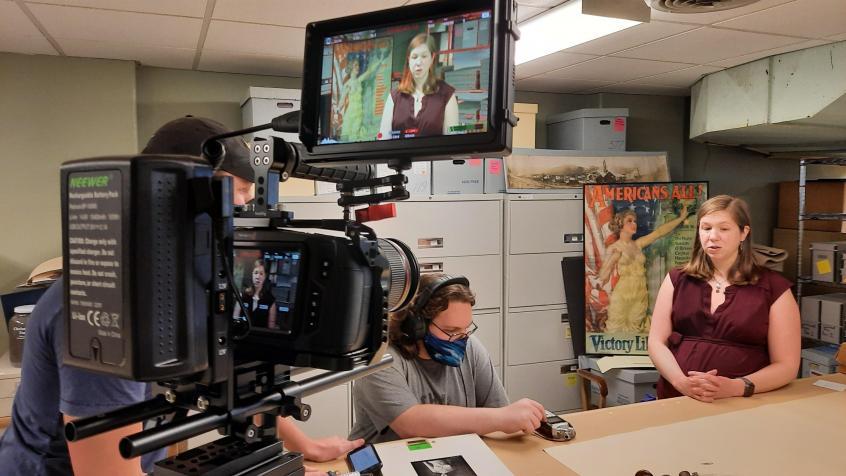Community-engaged courses go virtual
Media Production for Community benefits students and nonprofits
For over five years, Andie Walla and her Media Production for Community students have worked with local nonprofit organizations to produce promotional videos highlighting the organization. Walla and her students partner with different nonprofits year to year and this year they worked with the Dairy Barn Arts Center and Southeast Ohio History Center.
Teams of students meet with their nonprofit clients throughout the semester to discuss the scope of work and focus of each video production project, production logistics, and the final deliverables. The student teams then work together to shoot, edit and finalize the promotional videos for the nonprofits.
This year, Walla worked with partners and students to overcome barriers that emerged due to the pandemic, and emphasized that open communication is a critical key to meaningful community engagement. All student-client meetings were conducted virtually rather than in person, students provided their own transportation to shoot locations, and masking and social distancing protocols were followed during production. Walla and her students felt it was important to ensure a safe and welcoming shooting environment to ensure safety as well as a quality experience and final product for partners.
The final deliverables are typically provided in a few formats so nonprofits are able to use them in a variety of ways, including short social media clips as well as longer more in-depth pieces. For nonprofits, the promotional content that the students develop is impactful to raise awareness about their organizations, mission, and services they provide to the community, and they can also serve as useful tools for engaging their stakeholders. Students produced “How-To” videos for the Diary Barn that can be used for virtual arts engagement, and a piece focused on the resources available at the Southeast Ohio History Center and ways teachers can engage with them to teach local history in their classes.
For students, Walla emphasizes the importance of client-based production experiences. Through engaging with nonprofit partners to develop their projects, student gain critical soft skills like interpersonal communication, relationship development, and professionalism, while also applying their technical skills in a real work environment.
Another important learning outcome for students is a deepening of their understanding and sense of belonging in Southeast Ohio. Walla intentionally designed her C-Course to foster these outcomes in her students. “When you live in an area,” she said, “you feel a greater connection to it if you are actively learning about it.”
Students engage with community through Sociology of Appalachia class
In her Sociology of Appalachia course, Dr. Rachel Terman partners with Little Cities of Black Diamonds to develop and implement program evaluation for Little Cities Day every fall. Traditionally, Little Cities Day is a community festival that includes a significant focus on public history and regional arts and culture. Prior to the event, students meet with the Little Cities Planning Council to develop the evaluation strategy and survey and then, typically, distribute the survey in person on the day of the festival. They then analyze the survey results and deliver a final report and presentation to the Little Cities Planning Council.
This year, instead of an in-person event, Little Cities Day was transformed into “Little Cities Fest,” a week of online events celebrating the history of the region. Each day online thematic content was released related to a different topic, all around the broad theme of exploring the 1920s as compared to the 2020s.
Rather than meeting with the Planning Council in person, planning was conducted via Zoom. Dr, Terman stated that, while she missed the in-person engagement, this transition actually served to reduce participation barriers for many students, who otherwise would normally need to travel to Shawnee for these meetings. Surveys were distributed to participants online, and the final presentation was also given via Zoom.
“I’m interested in using this project to look at Appalachia from a sociological perspective,” said Dr. Terman. “There is a tendency to focus on social problems [in Appalachia], but I think that focusing on a small organization that does a lot of community-building with limited capacity in small communities helps students to understand the agency of Appalachian people and the power of rural communities despite challenges they face.” Students also develop key survey design, data collection, social science analysis and methodology skills.
The report the students delivered to the Planning Council provides useful participant feedback that helps to measure program goals and guide future planning efforts for Little Cities Day. This year they also gained deeper understanding of the potential for online engagement; Usually the festival attracts people from local communities and a couple other nearby urban centers, but this year social media analytics tracking showed reach much father beyond that—nationally and internationally.
“As a faculty member teaching about Appalachia, to me community engagement is an imperative,” said Dr. Terman. “We are in the place we’re learning about, and to be disengaged from the community just seems like an inaccurate way to teach the class—it would fail the students as well as the university in our obligations to the community. There’s so much potential for the university and communities to collaborate and develop positive partnerships.
